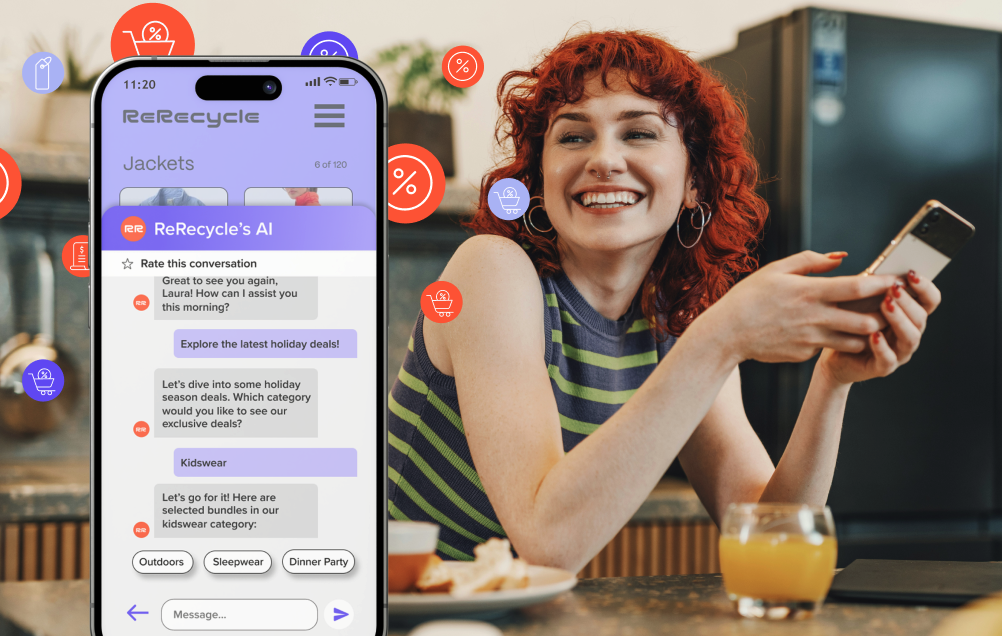Playbook: 10 Ways to Create a Superior eCommerce Customer Experience
A step-by-step playbook to supercharge sales
Fierce competition means brands are no longer competing on price and product alone. And, while Amazon has taken the lion’s share of sales for a long time, smaller brands are fighting back.
They can offer what Amazon can’t: a truly personalized and niche experience.
It’s why brands like Warby Parker and Bombas are rising stars despite solely selling glasses and socks. As well as creating high-quality, in-demand products, these brands are putting their customers at the center of everything and putting everything they have into creating an exceptional ecommerce customer experience.
Here’s how you can create a superior ecommerce customer experience to drive more sales.
1. Identify common friction points
You have a wealth of data at your fingertips that provides a detailed insight into how customers arrive on your site and how their journey maps out from there. Behavioral data shows what pages customers visit the most, how often they add products to their carts, and where they’re dropping off during the buying journey. It can show you insights like:

- The pages that have trouble converting
- Products with the least amount of customers
- How many customers aren’t adding products to their carts
- The points where customers are most likely to leave your site
Think about it: there’s clearly a problem if shoppers are viewing multiple products but not adding any to their carts. Understanding where these friction points crop up means you can reinvent them in a way that retains shoppers and keeps them engaged.
It might simply be that the “Add to Cart” button is hidden away below the fold. Moving it to the top of the page is a tiny change but can dramatically increase conversions and the ecommerce customer experience. Researching friction points and making tweaks like this can capture low-hanging fruit and iron out some of the small-but-mighty kinks in the customer journey.
How to identify common friction points with Rep:
Rep’s robust analytics dashboard deep dives into customer behavior throughout the entirety of the sales funnel. It visualizes how traffic moves between different pages on your site and where the most common drop-off points are. Pair this with user testing and customer surveys to add context to the data and understand the customer journey.
Strategy in action
Underoutfit found that customers weren’t putting items into their carts. They were showing interest on product pages, but not taking it any further. By implementing a Rep sales associate, the brand soon discovered that shoppers had too many unanswered questions about the material, fit, and support of the brand’s products. By answering these questions, the brand increased conversion rates by 315%.

2. Turn your store into a personalized catalog
Site navigation plays a huge role in the ecommerce customer experience. If a shopper can’t find what they’re looking for, there’s a good chance they’ll go elsewhere never to return again. On the flip side, being able to find exactly what they want in record time is a surefire way to secure long-term customer loyalty–the convenience of finding products quickly instills trust and builds an enjoyable experience.
Making it easy for customers to find the right products will set you apart from the rest. In fact, 60% of sites don’t divide categories and subcategories into manageable chunks. As well as creating an intuitive range of product categories, you can also implement AI-powered personalization technology that adapts your store layout to suit each individual customer. For example, you can spotlight your latest vegan trainers to a shopper who has shown previous interest in your vegan shoe collection.
How to turn your store into a personalized catalog with Rep:
Rep’s AI-powered personalization technology dynamically changes your store layout based on a customer’s previous browsing history. It brings relevant products to the forefront and turns your store into a personalized digital catalog.
Strategy in action
Poly and Bark implemented an AI-powered sales associate to offer personalized assistance. The bot automatically pops up when a shopper visits a specific page or shows interest in a certain product. Through a series of questions, the bot guides users toward the right product for their needs.

3. Create seamless ad campaigns
It’s tricky to create a tailored experience through multiple ad campaigns. This is because it’s near-on impossible to customize product pages or ad landing pages so that they match the messaging of several different campaigns at scale. As a result, customers can get confused quickly. They might click on an ad they’re interested in, only to be directed to a page that doesn’t include the information that originally drew them to the ad.
For example, if an ad talks about vegan shoes but leads to a generic shoe product page that only briefly references the vegan material halfway down the page, it can put customers off. Ideally, you want to highlight the vegan part on the product page or ad landing page because that’s what originally encouraged the customer to click through.
This kind of miscommunication can be detrimental to your budget, especially since acquisition costs are at an all-time high. It’s not cheap to reach new customers, so haphazardly pointing them toward a page that doesn’t completely match the sentiment of the original ad is essentially a waste of money.
Instead, try aligning the messaging of each individual ad to the landing page attached to it. This will create a seamless experience for shoppers who click through and will keep the shopping journey in full swing. Giving customers what they expect will secure conversions and reduce frustration, which overall will improve the ecommerce customer experience across your site.
How to create seamless ad campaigns with Rep:
Rep’s dynamic technology makes it possible to implement AI-powered sales associates on the landing pages of each ad campaign. These associates can speak to customers, answer questions, and continue with the messaging of each campaign.
Strategy in action
Herbal tea brand Herbaly has a host of different ad campaigns running, each targeting a different health benefit. But, since health is such a subjective, personal thing, it found that shoppers still had questions when they arrived on the accompanying landing page. To maintain consistency and personalize the experience, Herbaly embedded an AI-powered sales associate to ask questions relevant to the original ad to guide shoppers toward best-fit products.

4. Improve the product discovery process
Clunky menus and hit-and-miss search functions are a thing of the past. Now, shoppers want a slick and pain-free way to find the products they’re looking for. Instead of forcing them to trawl through endless product pages in the hope that they’ll stumble across something interesting, help them out by asking a few engaging questions.
You can do this with an e-commerce quiz, which asks shoppers a few questions about their preferences in order to direct them to the right product. 91% of consumers say they’re more likely to shop with brands that provide offers and product recommendations that are relevant to their specific needs. You can ask questions that increasingly hone in on what they’re looking for – for example, if you sell a range of perfumes, you might ask:
- Do you prefer floral or fruity scents?
- Are you looking for a perfume for a special occasion?
Not only will this help shoppers who know what they want to find products faster, but it will also help shoppers who aren’t sure what they’re looking for to discover new products in the categories they’re most interested in.
How to improve the product discovery process with Rep:
Rep’s technology lets you train your AI-powered sales associate to ask and answer relevant customer questions before directing shoppers to relevant products. It uses behavioral data and the information provided to create a personalized shopping experience and suggest product pages that are the best fit.
Strategy in action
Fresh Roasted Coffee asks shoppers key questions to drill down into exactly what they’re looking for. It asks “what kind of caffeination do you prefer” and “what roast level do you prefer” so it can provide highly-targeted product suggestions. Doing this created a better brand experience and increased revenue by 15%.

5. Deliver relevant information at the right time
Not all customers need the same information at the same time. Someone who has just landed on your site for the first time and knows nothing about your brand has a completely different set of needs than a shopper who has bought from you before and is back to browse your latest product line.
Sure, a popup that appears after 10 seconds offering a 10% discount can secure some sales, but it might be that you’re serving it too early to the wrong shoppers. In this case, you’re potentially turning off a future customer who feels bombarded with popups before they’ve even had a chance to see what you sell.
Avoid this by approaching customers at the right moment with the right offers. This might be a discount, a product recommendation, or educational content that will help them with their purchase. For example, if someone has shown an interest in your gin mixers, you might share a couple of recipes with them and offer a discount on a mixer bundle.
How to deliver relevant information at the right time with Rep:
Rep’s intelligent AI can identify a customer’s needs in real-time based on their browsing behavior and serve them relevant assistance depending on where they are in the sales funnel. It can provide educational content about your brand to shoppers who have landed on your site for the first time or a sizeable discount to loyal customers who have made multiple purchases from your store in the past.
Strategy in action
Clothing brand THEY welcomes back customers who have been on the site before and shares a selection of options that best fit their needs. They initially struggled to replicate the in-person connection they had with customers in-store, but sharing information based on where a shopper was in the sales cycle helped the brand increase conversion rates by 3.2X.

6. Personalize the entire shopping experience
Using a customer’s first name can increase conversion rates (just like using a recipient’s first name in an email subject line is likely to increase open rates). But why stop there? The more you personalize the buying journey from the moment a shopper lands on your site, to long after they’ve become a paying customer, the easier it is to secure long-term loyalty and create an enjoyable ecommerce customer experience.
Use key data points you have about customers to segment them based on their shopping preferences, their preferred social media platform, their age, and their lifestyle so you can send relevant communications. You can get really granular with your personalization efforts, too–something as simple as acknowledging the time of day and local weather can lead to higher sales.
How to personalize the entire shopping experience with Rep:
Rep’s AI-powered sales associates go one step further than simply calling customers out by name. They can also share valuable, relevant sales information, and adapt the conversation based on the answers a shopper has provided. For example, if they’ve said they’re shopping for a special occasion, Rep can address that to create a stronger connection.
Strategy in action
Clothing brand Zavi asks customers what occasion they’re shopping for and provides product suggestions based on their responses. This added connection and the instant engagement with shoppers helped generate an immediate 11% increase in sales.

7. Implement a free shipping threshold
Almost 70% of shoppers abandon their cart before checkout, and the number one reason they do so is because of unexpected shipping costs. The last thing you want is customers to get excited about your products, make it all the way to checkout, and then drop off because they’re slammed with an additional shipping fee.
While it’s not always as simple as offering free shipping, you can implement a free shipping threshold. Then, you can automatically notify customers about free shipping if they spend X amount to encourage them to add more products to their cart and enjoy free shipping at the same time.
How to implement a free shipping threshold with Rep:
Rep’s AI-powered sales associates can be trained to proactively approach customers who have started to add products to their carts, but who haven’t yet reached the free shipping threshold. The associates can remind them about the free shipping, highlight how much more they need to spend to get there, and even offer complementary products that will help them reach the threshold.
Strategy in action
Zavi automatically reminds customers about the $100 free shipping threshold and offers to recommend relevant products a shopper might like based on other items in their cart.

8. Use reviews to better understand customers
Reviews are a great asset for any brand. They show you how customers see your products and relate to them, as well as what you can improve about your brand and what you sell. 93% of consumers actively read reviews before they make a purchase–not only do they drive sales and keep the sales cycle in motion, but you can also use data from your reviews to match customer requests with relevant products and change product descriptions.
Start by sprinkling reviews throughout the sales cycle, including on:
- Relevant product pages
- In customer carts
- At the point of sale
- In product recommendation emails
Take it one step further too. Analyze data extracted from customer reviews to better understand how different audience segments relate to your products so that you can recommend the right products to the right people in the future. For example, if you notice that the majority of people who buy your handmade, patterned table candles are women in their 30s, you can recommend them to future shoppers who fit that profile.
How to use reviews to better understand customers with Rep:
Rep’s AI-powered sales associate absorbs user-generated content like reviews to become smarter and better understand how customers relate to your products. This information can then be used during sales conversations with customers to provide more apt product recommendations.
Strategy in action
Clothing brand Zavi uses an AI-powered sales associate to categorize clothes into groups that aren’t available on the website. It does this based on customer reviews and information past shoppers have provided. The bot can then ask customers questions about the occasion they’re shopping for and recommend relevant products.

9. Offer immediate discounts
No one wants to hang around in their inbox waiting for a much-promised discount to land. Instead of collecting leads and sending a discount email hours after a shopper has expressed interest, offer it right away while they’re actively in buy mode. Timing is everything in ecommerce–wait too long, and shoppers will lose interest and intent and, to top it off, will go elsewhere to buy.
You can also bypass inboxes by sending coupons directly to customers on-site via a chatbot or online sales associate.
How to offer immediate discounts with Rep:
Rep’s sales associates can grab the attention of consumers and offer a discount via the automated chatbox. When customers opt for a discount, you can encourage them to subscribe to your email or SMS list to nurture them further.
Strategy in action
One of the first things jewelry brand Pavoi asks customers when they land on its site is whether they’d like a discount. If they opt-in, shoppers are encouraged to subscribe to claim their 10% first-time buyer’s discount. This played a part in the brand boosting sales by 11%.

10. Create context for customer service reps
When a customer contacts support, they usually go through a series of questions so that the rep can get to the bottom of the problem. But, if the customer has another issue in the future and reaches back out to support, all their previous information is often forgotten and they have to start again from scratch.
Instead of forcing shoppers to revert back to basics every time they need to speak to a real human, use insights captured from an AI helpdesk to populate shopper profiles with relevant information. This adds more context to the customer’s behavior and can help reps solve problems much quicker. Helpdesks can collect insights such as:

- Previously purchased products
- Past issues a customer has had
- How often a shopper has contacted support
- Detailed customer attributes, like size, age, and product preferences
All of this information can create a backdrop for human representatives so they have a pre-established image of a customer when they come for help. As a result, they’re able to provide a quicker, more relevant response.
How to create context for customer service reps with Rep:
Unfortunately, Rep’s AI-powered sales assistants don’t have all the answers–not yet, anyway. When it draws a blank, it automatically diverts the conversation to a human customer service rep, but instead of shoppers having to explain their situation again to a real person, Rep sends the original information provided (plus any extra details it has about the customer) to the support team. As well as sharing the main issue, the sales assistant can also share the actions a customer has taken on the website, including which product pages they have visited the most and past conversations they’ve had with the bot.
Strategy in action
THEY offers shoppers the chance to talk to a human through its sales assistant bot. Customers can provide information about their issue, but the bot also passes along other relevant information a shopper has provided plus their past browsing history to give real-life service reps context.

How personalization enhances ecommerce customer experience
Personalization is key for exceptional ecommerce customer experiences. By personalizing interactions,
Increased Sales and Profits
Personalization lets businesses tailor their offerings to match customer wants. As a result, they see more engagement and greater satisfaction. This targeted approach encourages repeat purchases and fosters loyalty.
Personalization Impact on Sales and Profits:
- Companies that excel at personalization generate 40% more revenue.
- Personalization can reduce customer acquisition costs by 50%.
Higher Conversion Rates
Personalization helps customers discover what they want. It offers suggestions for content and products based on their interests.
When products meet customer needs, they are more likely to buy. Customers engage better when they meet their needs and desires.
How Personalization Improves Conversion Rates:
- Dynamic Content: Displaying user-adaptive content increases engagement.
- Customized Landing Pages: Landing pages that match user preferences boost conversion rates.
Accelerated Customer Journey
The customer's journey through the buying process is accelerated with personalization. Businesses that create personalized experiences can better guide customers by anticipating their needs and reducing friction

Fierce competition means ecommerce customer experience is crucial
To succeed in the fierce competition today, e-commerce brands have to put the customer at the center of everything they do. This means creating a superior ecommerce customer experience that answers shopper questions quickly and in the most relevant way possible. Rep’s AI-powered sales assistants provide an instant way to connect with shoppers, answer objections and questions, and remove friction from the buying process to drive sales and increase conversions. Request a demo today!

Quick Answers and FAQs
How can an online store enhance customer retention and build loyal customers?
Loyalty doesn’t happen by accident. It’s the result of consistent, thoughtful experiences that make customers feel valued from day one. Online stores can increase retention by focusing on each phase of the customer journey—from the first purchase to long-term engagement.
Phase 1: Personalize the First Experience
Every loyal customer starts as a first-time visitor. To make that first experience stick:
- Use browsing and purchase data to recommend relevant products
- Tailor homepage content, offers, and emails to customer preferences
- Trigger welcome discounts or bundles that match their behavior
First impressions count—especially when they feel personal.
Phase 2: Reward the Relationship
Once a customer buys, give them a reason to come back.
- Launch a tiered loyalty program with meaningful rewards for repeat purchases
- Offer early access to new products or limited-time deals for top-tier members
- Keep it easy: let them track points, rewards, and perks from their account
Phase 3: Stay Engaged Post-Purchase
Too many brands go silent after the sale. Don’t be one of them.
- Send a personalized thank-you or how-to content that supports their purchase
- Ask for feedback—and show that you’re listening
- Automate re-engagement messages for customers who haven’t visited in a while
Phase 4: Support That Builds Trust
Great customer service doesn’t just solve problems—it earns loyalty.
- Offer live chat, email, and phone support with fast, friendly responses
- Empower your team to go beyond scripts and create real connections
- Turn support interactions into opportunities to offer personalized help or product suggestions
Trust is retention’s secret weapon—and it’s earned one interaction at a time.
How should an eCommerce business measure the customer experience to drive growth?
Customer experience (CX) is one of the most reliable growth levers in eCommerce—but only if you know how to measure it. Tracking traffic and revenue alone won’t reveal what your customers actually experience. To drive real growth, you need a system that captures satisfaction, effort, loyalty, and behavior across the full journey.
A data-driven approach to CX combines metrics, customer signals, and feedback into one continuous loop of improvement. Here’s how to structure it:
1. Satisfaction: Are Customers Happy With What They Just Experienced?
Capture immediate emotional response after key interactions.
- Net Promoter Score (NPS): Measures loyalty and referral likelihood
- Customer Satisfaction Score (CSAT): Collected post-purchase or post-support
- Post-interaction surveys: Short, targeted, and context-specific
These metrics reveal how customers feel in the moment—and whether they’re likely to come back.
2. Effort: How Easy Is It to Buy From You?
Measure how much friction exists in the customer journey.
- Customer Effort Score (CES): How hard was it to complete an action?
- Time to complete checkout: Indicator of UX friction
- Support contact frequency: High volume often signals poor experience
Lower effort = higher conversions and loyalty. It’s that simple.
3. Behavior: What Do Happy (and Unhappy) Customers Actually Do?
Beyond what customers say—track what they do.
- Repeat purchase rate: A strong indicator of satisfaction
- Time between purchases: Helps gauge long-term engagement
- Conversion path tracking: Shows which flows lead to success (and which don’t)
- Session recordings & heatmaps: Reveal hesitation and drop-off points
4. Voice of the Customer: What Are They Telling You—Directly or Indirectly?
Don’t just measure metrics—listen to what customers say and feel.
- Support transcripts: Uncover patterns and root causes
- Review analysis: Use NLP to categorize feedback by sentiment and topic
- Real-time feedback during interactions: Tools like Rep AI surface pain points as they happen
This qualitative layer helps you move from numbers to real insight.
Why It Works
Measuring CX across these four pillars helps eCommerce businesses prioritize improvements that directly impact growth—whether that’s higher conversions, better retention, or greater lifetime value. The key is to connect experience data to action.


.png)










